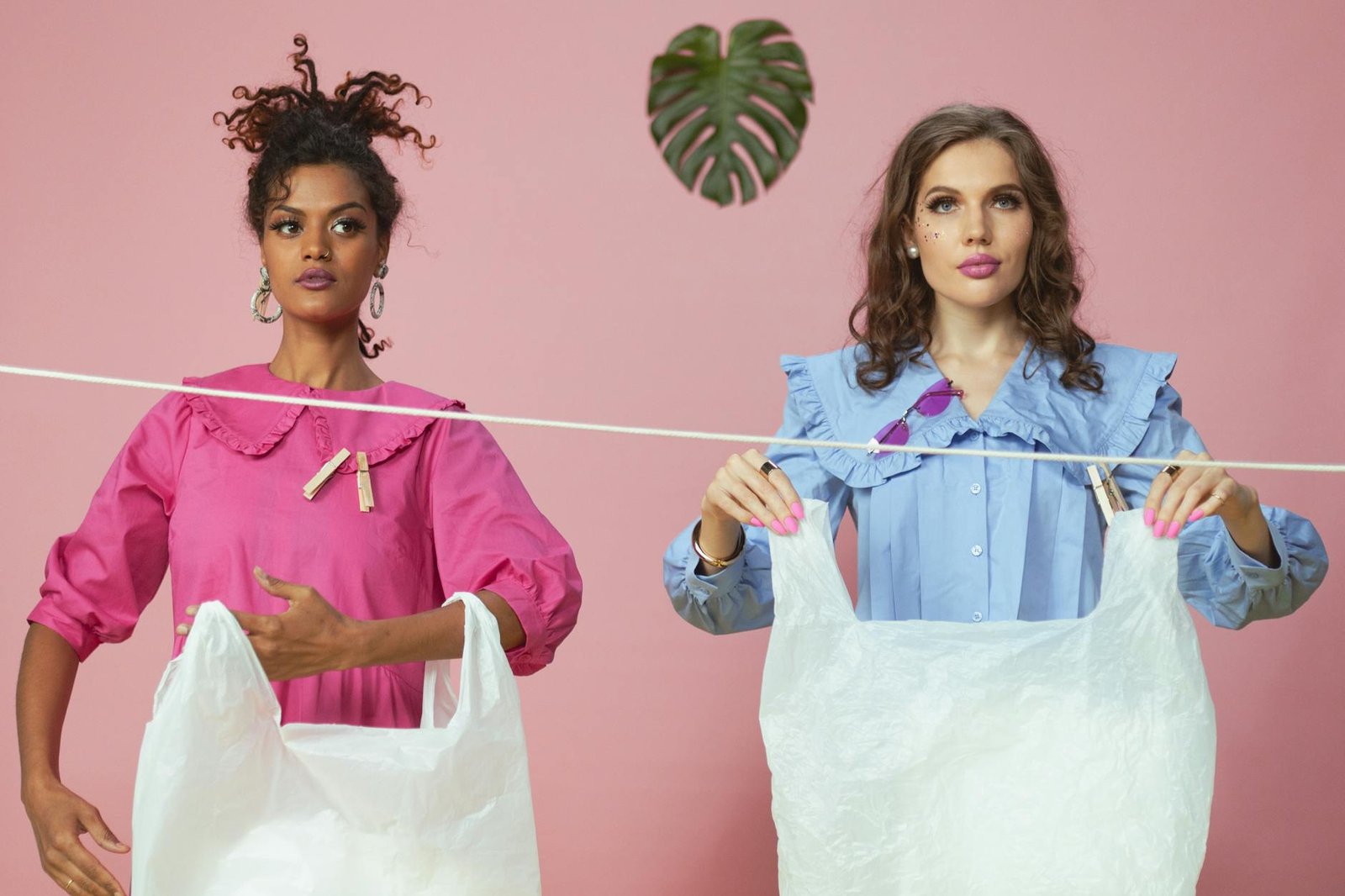Last Updated on December 11, 2024 by Daniele Lima
How to Dress Without Compromising the Planet
Fashion has evolved beyond passing trends and rampant consumerism. Today, clothing is not just a matter of style, but also of conscience and responsibility. Eco-fashion, or sustainable fashion, appears to be a powerful response to growing environmental and social concerns. In a world where the fashion industry is one of the biggest polluters, choosing what to wear can be an act of sustainability and respect for the planet. In this article, we will explore how eco-fashion not only promotes a unique, conscious style but also plays a crucial role in building a greener, more ethical future. Let’s find out how you can combine your passion for fashion with your commitment to protecting the environment, without compromising on style.
She goes further to use sustainable materials; which includes a cycle of fully responsible production, or from cultivation and raw material up to the conscious disposal of the pieces. Brands that use this approach commit to ethical practices, such as the use of organic cotton, and dyes and the reduction of waste through recycling and recycling. Furthermore, sustainable fashion values fair work, which guarantees good conditions to the workers throughout the production chain. To choose ecological fashion, the consumer not only buys clothes but also raisin to do part of a global movement that seeks to minimize environmental impact and promote a fairer and more balanced world.
Table of Contents
Fashion’s Environmental Crisis: Understanding the Industry’s Impact
The fashion industry is one of the most polluting in the world, being responsible for approximately 10% of global carbon emissions, according to the UN report. Furthermore, this industry consumes vast amounts of water and uses chemicals that contaminate soils and rivers, damaging entire ecosystems. The fast and cheap production model, known as “fast fashion”, encourages unrestrained consumption and rapid disposal of items, generating a huge volume of textile waste that ends up in landfills.
The production of a single cotton t-shirt, for example, can consume up to 2,700 liters of water — the equivalent of what a person drinks in two and a half years. Furthermore, conventional cotton cultivation makes extensive use of pesticides and fertilizers, which pollute waterways and affect the health of local communities. In such a worrying scenario, sustainable fashion appears as a viable and necessary alternative to reverse this situation.
What is Sustainable Fashion? Defining Eco-Conscious Style

Sustainable fashion involves a set of practices that seek to minimize the environmental and social impact of clothing production and consumption. This includes the use of environmentally friendly materials such as organic cotton, linen, hemp, and recycled fabrics, as well as production processes that use fewer natural resources and avoid the use of harmful chemicals.
Furthermore, sustainable fashion promotes the appreciation of fair work, ensuring that workers in the fashion industry receive decent wages and work in safe conditions. Many sustainable brands adopt fair trade practices and transparency in the production chain, ensuring that consumers know exactly where their clothes come from and how they were made.
Sustainable Materials: Fabrics Saving Our Planet
One of the main pillars of ecological fashion is the use of sustainable materials. By choosing fabrics that have a lower environmental impact, brands and consumers can significantly reduce fashion’s ecological footprint. Here are some of the most common materials in sustainable fashion:
Organic Cotton: Grown without the use of pesticides and synthetic fertilizers, organic cotton is a much more sustainable alternative to conventional cotton. Its production uses less water and promotes soil health, in addition to being safer for workers.
Linen: Linen is one of the oldest and most sustainable fabrics in the world. Its production uses less water and chemicals than cotton, and the flax plant is completely usable, which reduces waste.
Tencel (Lyocell): Made from wood cellulose, Tencel is a biodegradable and sustainable fabric, produced through a closed-loop process that reuses almost all solvents and water used in production.
Recycled Polyester: Recycled polyester is made from recycled plastic bottles or textile waste, reducing the need to produce new polyester, which is derived from petroleum. This helps reduce plastic waste and the demand for fossil fuels.
Sustainable Materials: Fabrics Saving Our Planet
Discover eco-friendly fabrics that are shaping the future of sustainable fashion.
| Fabric | Description |
|---|---|
| Organic Cotton | Grown without pesticides or synthetic fertilizers, it uses less water and promotes soil health. Learn more about its benefits at WWF’s Guide to Organic Cotton. |
| Linen | A water-efficient fabric made from the flax plant, with minimal waste. Explore its sustainability advantages at Common Objective’s Linen Guide. |
| Tencel (Lyocell) | Produced from wood cellulose using a closed-loop process that minimizes waste. |
| Recycled Polyester | Made from recycled plastics, it reduces plastic waste and fossil fuel demand. |
Consumer Power: Your Role in Sustainable Fashion Revolution
The success of sustainable fashion depends not only on the practices adopted by brands but also on the choices made by consumers. Adopting a sustainable lifestyle implies changes in consumption habits, which include the way we buy and care for our clothes.
Here are some practices that can help consumers support sustainable fashion:
Buy Less and Better: Instead of buying lots of cheap, low-quality pieces, opt for fewer items that are high quality and durable. This not only reduces waste but also saves money in the long run.
Prioritize Sustainable Brands: Whenever possible, choose brands that adopt sustainable and transparent practices. Research the production policies and materials used by brands before making a purchase.
Take care of Clothes: Extending the lifespan of clothes is an effective way to practice sustainable fashion. This includes washing clothes properly, repairing damaged items, and storing them properly.
Support the Circular Economy: The circular economy in fashion involves buying and selling second-hand clothes, exchanging clothes, and recycling fabrics. This helps reduce waste and the demand for new resources.
Challenges and Opportunities in Eco-Friendly Fashion
Although sustainable fashion is gaining more and more space, it still faces significant challenges. The higher price of sustainable products can be a deterrent for many consumers, and the lack of clear regulation can make it difficult to differentiate between truly sustainable brands and those that merely adopt “greenwashing” practices.
However, the opportunities are vast. The growing demand for transparency and ethics in fashion is putting pressure on big brands to adopt more responsible practices. Additionally, technological innovation is enabling the development of new materials and processes that can make sustainable fashion more accessible and efficient.
Interactive Wardrobe Sustainability Tools
Understand your wardrobe’s impact on the environment, visualize its sustainability, and learn about material lifecycles.
Wardrobe Sustainability Analyzer
Enter details about your wardrobe to analyze its environmental footprint.
Environmental Impact Infographic Generator
View the environmental impact of your wardrobe choices as a graphical summary.
Material Lifecycle Interactive Diagram
Learn about the lifecycle of popular clothing materials and their environmental impact.
Select a material to view its lifecycle and impact.
Building a Greener Wardrobe: Practical Sustainable Fashion Tips
Sustainable fashion is more than a passing trend; it is an urgent need in a world facing unprecedented environmental challenges. By making conscious choices, we can use fashion as a powerful tool to promote sustainability and social well-being.
By choosing eco-friendly materials, supporting brands committed to ethical practices, and taking better care of our clothes, we can contribute to a future where fashion is not a burden on the planet, but a force for good. Sustainable fashion allows us to express our personal style while being part of a global movement to protect the environment and promote social justice.
Dressing consciously is a small step that can have a big impact. It’s a way of aligning our daily choices with our values and literally creating a better future for everyone.
Sustainable Fashion – FAQ:
Is sustainable fashion more expensive?
While initially pricier, sustainable clothing often lasts longer, providing better long-term value and reducing overall consumption.
How can I start adopting sustainable fashion?
Begin by buying fewer, higher-quality pieces, researching ethical brands, and caring for your existing clothes carefully.
What materials are most sustainable?
Organic cotton, linen, Tencel, and recycled polyester are among the most environmentally friendly fabrics.
How does sustainable fashion help the environment?
It reduces water consumption, minimizes chemical usage, decreases carbon emissions, and promotes fair labor practices.
Can sustainable fashion be stylish?
Absolutely! Many sustainable brands offer trendy, innovative designs that don’t compromise on aesthetics.









Leave a Reply